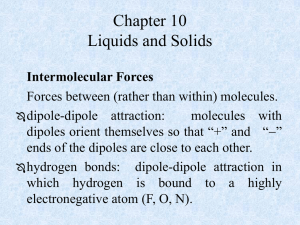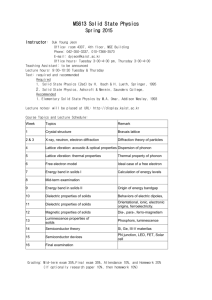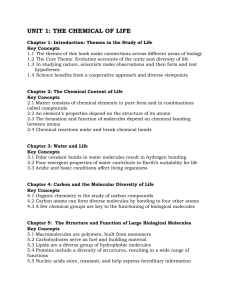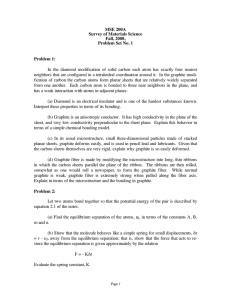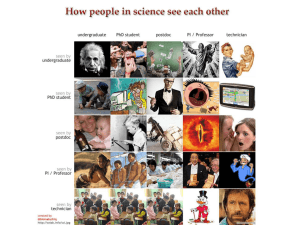Chapter 10 PPT
advertisement
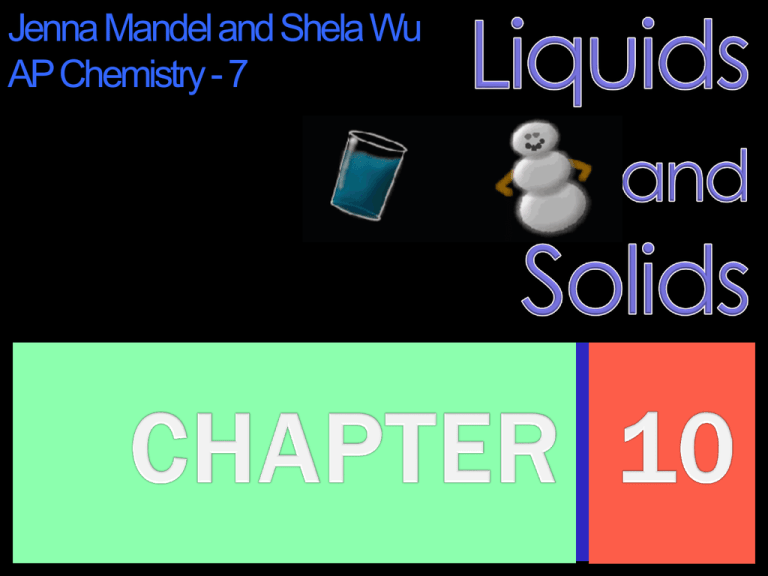
Jenna Mandel and Shela Wu AP Chemistry - 7 Intermolecular BETWEEN MOLECULES VS Intramolecular KEEPS MOLECULE TOGETHER When something undergoes a phase change, the changes occur in the intermolecular forces. Occurs between two polar molecules HYDROGEN BONDING Strong form of dipole-dipole attractions Occurs in molecules with hydrogen that is bonded with an element with a high E.N. High difference in electronegativity & small size contributes to its great strength INSTANTANEOUS DIPOLES IN LARGE ATOMS, CAN BE MORE SIGNIFICANT THAN DIPOLEDIPOLE FORCES London Dispersion Forces OCCURS BET WEEN 2 NON-POLAR MOLECULES surface tension the resistance of a liquid to an increase in its surface area capillary action spontaneous rising of a liquid in a narrow tube a result of adhesion and cohesion Concave shape of meniscus shows adhesive > cohesive Viscosity: measure of liquid’s resistance to flow adhesive versus cohesive force between liquid and surrounding liquid particles attracted to themselves as apposed to amorphous solids… LATTICE describes the locations of the pieces in a UNIT CELL smallest repeating unit of the lattice crystalline solid ions at lattice points small molecules at lattice points atoms at lattice points Metallic Solids Positively charged & held together by neutrons. Delocalized electron sea theory atoms at lattice points Network Solids Atoms bond covalently in a continuous network. Strong Bonds -> High mp & bp Do not conduct electricity atoms at lattice points Group 8A Solids Noble gases bonded with London Dispersion Forces Occur at very low temperatures! It’s ductile! It’s malleable! strong & nondirectional ELECTRON SEA MODEL metal cations in valence econduct heat and electricity malleable and ductile Diamond VERSUS Graphite Hardest naturally occurring substance Slippery, black, & a conductor carbon surrounded by a tetrahedral Layers of carbon atoms in 6 member rings sp3 hybridization sp2 hybridization large gap between filled and empty levels in energy diagram weak bonding between layers accounts for slippery texture PHASE CHANGES Heat of Vaporization ENERGY NEEDED TO VAPORIZE A MOLE OF LIQUID When does a liquid boil? its vapor pressure EQUALS pressure of the environment Pvap,T ln Pvap,T 1 2 Hvap 1 1 = R T T 2 1 ΔHvap = enthalpy of vaporization R = 8.3145 J/K·mol T = temperature (kelvin) C=constant Determine heat of vaporization, and can also be used to find Pvap Rate of evaporation remains constant while rate of condensation increases as number of molecules in vapor phase increases, until they become equal, and thus reach equilibrium.




